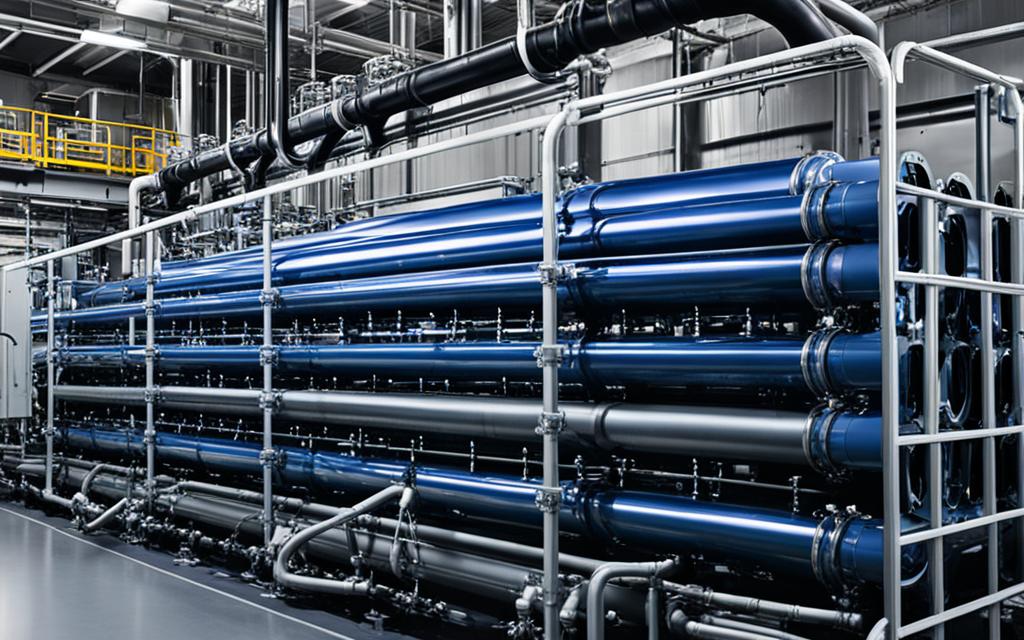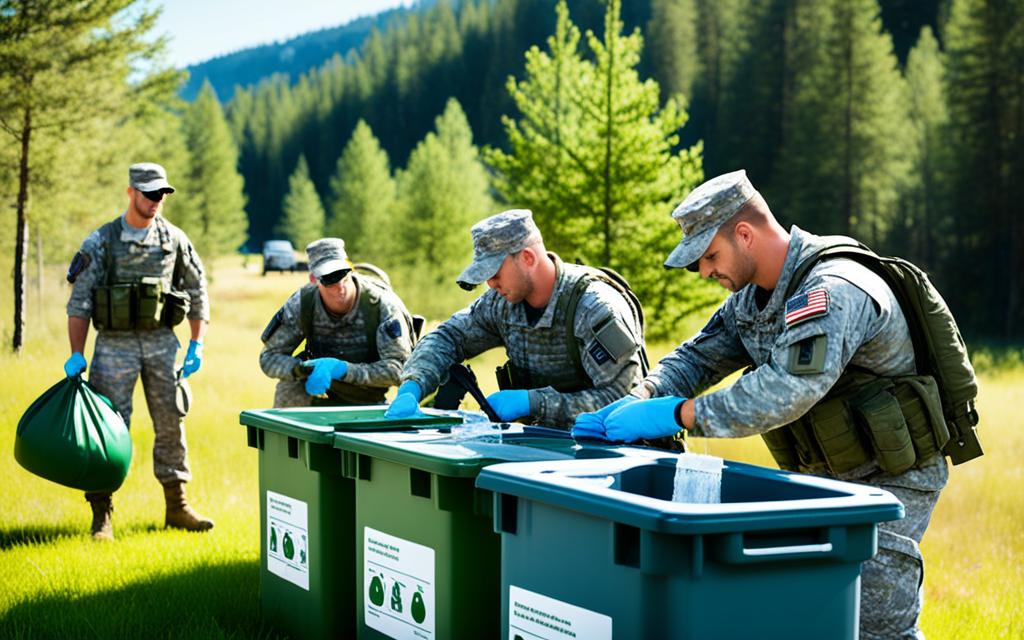The US military is fighting two battles: against adversaries and environmental harm. Their strategy includes an unusual friend: solvent recycling. This move towards eco-friendly operations is now a key part of their plan. By 2020, the US was importing over half of its germanium, a vital material for advanced military gear.
This shows how much the US depends on foreign resources. The Defense Logistics Agency’s (DLA) recycling efforts are mainly from Tobyhanna Army Depot in Pennsylvania. They plan to recycle 2,200 to 3,000 kilograms of germanium each year. This is about 10% of the country’s yearly requirement.
Germanium is crucial for military equipment like Abrams tanks and Apache helicopters, making resource management crucial. The DLA’s focus on recycling materials such as germanium shows a strong commitment. They are looking for sustainable ways to protect the nation. This method not only keeps vital materials available but also helps the military be more sustainable in the future.
Key Takeaways
- Strategic resource management through recycling germanium serves national security and ecological goals.
- The DLA’s recycling program meets 10% of the US’s germanium needs, highlighting the benefits of in-house material recovery.
- Eco-friendly military operations leverage recycled materials to preserve critical infrastructure while minimizing environmental impact.
- Implementing solvent recycling in warfare supports a more sustainable defense supply chain.
- The strategic application of recycled germanium in military equipment underscores the Defense Department’s commitment to sustainability.
The Necessity Of Solvent Recycling In Military Operations
The US Army and Marine Corps consider environmental responsibility more than following rules. It’s key to their mission. The defense industry is moving towards greener ways of doing things. This includes finding better ways to handle military solvent recovery and defense industry solvent reuse. These efforts are vital for eco-friendly warzone solvent treatment and smart strategic resource management.
Overview Of Solvent Usage In The Defense Sector
Solvents play a big part in maintaining and cleaning military gear. Events like the Gulf War show us just how much solvent is needed. Because of this, the military must have good recycled solvents for military use. This ensures they can do their job well and care for the environment.
Impact Of Solvent Waste On The Environment And Warzones
Not dealing with solvents right can ruin natural areas and endanger health in conflict zones. A solid plan for combat solvent reclamation is needed. This helps limit environmental harm and supports eco-friendly warzone solvent treatment.
Strategic Benefits Of Recycling Solvents
Recycling solvents has many advantages. It saves money, reduces the need for new resources, and makes the military look more eco-friendly. These efforts match government rules on buying sustainable products and support the bigger goal of smart strategic resource management.
| Environmental Strategy | Army | Marine Corps |
|---|---|---|
| Environmental Training Importance | Integrated in Military Operations | Integral in Planning and Execution |
| Protection During Operations | Operational Guidelines Established | Emphasized Through Leadership |
| Assessment of Environmental Compliance | Ongoing at the Unit Level | Ongoing at the Unit Level |
| Health Hazard Management | Addressed through Risk Assessments | Preventive Measures and Training |
Set plans show how closely military actions and environmental care are linked. They remind us that recycling solvents is not just a choice. The military must be seen as a leader in modern, sustainable practices.
Military Solvent Recovery Techniques
The military is increasingly focusing on military solvent recovery and defense industry solvent reuse. These efforts are key to making defense activities sustainable. By concentrating on combat solvent reclamation and eco-friendly warzone solvent treatment, the military is helping the environment while keeping its operations running smoothly.
On-Base vs. Off-Base Recycling Methods
The military uses different approaches for recycling, depending on location. On-base recycling involves treating solvents right at the military bases. It uses the staff’s skills and their equipment. On the other hand, off-base recycling means hiring specialized companies to handle solvents safely. This way, they manage dangerous waste properly.
Government Accountability Office reports show it’s crucial to pick these companies wisely. The Department of Defense (DOD) has lost a lot of money due to bad waste handling by some contractors. So, choosing the right contractor is very important.
Technological Advances In Combat Solvent Reclamation
Technology is changing how the military deals with waste. New tech uses safe, water-based solvents that are better for the environment. These technologies play a big role in cleaning up and getting back clean solvents. They help in reducing dangerous waste and keeping the defense sector safe.
In 2005 alone, the DOD had to dispose of 132 million pounds of waste from its activities. This fact shows why it’s so critical to have better solvent recovery methods. It’s all about keeping the military ready but in a way that protects our planet.
The EPA and state agencies enforce strict rules to help these efforts. They require permits and check on the military’s practices every two years. These steps ensure that the military’s actions meet high environmental standards. Thus, they support the DOD in being responsible and eco-friendly.

The military makes a big effort to manage its environmental impact. They share some information about the consequences they face for not managing waste right. This careful information sharing shows how complex environmental issues can be for the defense. Yet, it shows how committed the military is to finding better ways to deal with waste.
Sustainable Solvent Management Strategies
Keeping a strong defense force means using sustainable solvent management practices. These practices focus on not harming the environment. By recycling and reusing materials, the defense industry lessens its environmental impact while staying top-notch in operations.
The Defense Logistics Agency (DLA) has a notable recycling program for germanium at Tobyhanna Army Depot in Pennsylvania. This effort is key in reusing defense industry solvents. It provides 2,200 to 3,000 kilograms of recycled germanium each year, covering up to 10% of U.S. needs.
In 2020, the U.S. needed about 30,000 kilograms of germanium, most of which came from other countries. Because germanium is rare and important for things like semiconductors, recycling within the country has become crucial.
Nearly all materials from recycling, including germanium, aluminum, and stainless steel, are saved. This process is efficient, and polymers are also recovered. The result is highly pure ingots—99.999% pure, in fact.
The recycling program uses eco-friendly solvents that are safe and water-based, showing a move towards better solvent management. Using green chemistry helps the defense reduce its environmental harm, making the military stronger and more mindful of the planet.
Adding germanium to the Strategic National Stockpile in the 1980s showed its importance. The efforts to recycle and reuse show a dedication to keeping the nation safe and eco-friendly. This strategy perfectly combines readiness for defense with caring for the environment.
Case Study: DOD’s Disposal Concepts For Used Solvents

In an age where solvent recycling in warfare is becoming more vital, the Department of Defense (DoD) is advancing eco-friendly solvent disposal. They focus on safe solvent disposal while following tough regulations. This marks a move to more sustainable military operations.
Identification Of Five Solvent Process Use Categories
The DoD has outlined major categories that lead to solvent waste. This understanding aids in crafting better battlefield solvent disposal methods. Categories include vapor degreasing and cold cleaning baths, paint stripping, thinning, and metal prep, all impacting the environment differently.
Cost-Effectiveness Of Recycling Versus Destructive Disposal
DoD studies show that recycling solvents beats destruction methods such as burning. This approach not only saves money but also protects the environment. It showcases the military’s dedication to environmentally safe warzone solvent handling.
| DoD Policy | DLA/DRMS Role | Disposal Management | Regional Responsibilities |
|---|---|---|---|
| Compliance with environmental regulations | Hazardous waste disposal services | Handling of toxicological, biological, and radiological waste | Technical support to DLA |
| Minimize hazardous property generation | Environmental compliance (DoDI 4715.6) | Certification before transportation | Hazardous property storage from off-site generators |
| Resource recovery and recycling | Disposal services preference | Contractor-generated waste management | DLA documentation and contract management |
- DoD’s policy supports stringent transport, storage, handling, and disposal procedures.
- DRMOs handle the receipt and storage of hazardous materials from off-site DoD sources.
- DLA/DRMS manages disposal actions and documentation related to hazardous property.
The stats show the DoD’s dedication to responsible solvent disposal. The DoD and DLA/DRMS work together to recycle solvents responsibly in warfare. This team effort highlights the balance between strategy, ethics, and environmental care.
Regulatory Considerations In Battlefield Solvent Disposal
Getting rid of solvents the right way on the battlefield is crucial. It’s not just about caring for the environment but also following the law. Military folks must understand federal and state rules about handling dangerous stuff like solvents. These rules are key for eco-friendly military actions. They make sure the health of people and the planet is a top priority.
Alignment With Federal And State Environmental Regulations
Following environmental laws is a must for legal battlefield solvent disposal. Military operations use advanced waste management methods that meet these laws, which avoids fines and helps the environment.
Addressing Regulatory Challenges In Warzones
Warzones make following environmental laws difficult. The chaos of battle makes it tough to maintain regular disposal methods. Yet, the need to follow these laws is crucial. It pushes the military to find new ways to get rid of solvents safely. This effort shows a commitment to protecting nature and protecting people during war.
- Number of shells fired at Verdun in 1916 by German artillery: 100,000 in the first hour
- Estimated total shells exchanged during the Verdun battle: 23 million
- Number of phosgene shells fired by Germans in one day: 75,000, containing approx. 137 tons of lethal chemical
- Total estimated toxic gases used in WWI: 125 million tons
We must grow our commitment to protecting the environment as military operations evolve. Remembering the past, like many munitions used in wars, is crucial. However, we also need to act now to avoid future environmental disasters. Learning from past wars can guide us in managing solvent disposal and keeping military operations green.
Eco-Friendly Warzone Solvent Treatment: Current Practices And Innovations
The importance of solvent recycling in modern warfare is growing. The military now focuses on eco-friendly practices, which shows its commitment to protecting the environment.
| Date | Event | Fund Amount |
|---|---|---|
| 1914 | Neutrality Proclamation Issued by President Woodrow Wilson | N/A |
| August 5, 1914 | Passing of House Joint Resolution 314 | $2.5 million |
| August 6, 1914 | Tennessee Sails with Gold to Falmouth | $4.5 million |
| August 29, 1914 | North Carolina Sails for Relief Efforts | $150,000 |
| February 4, 1915 | Germany Declares Submarine War Zone | N/A |
| January 28, 1915 | Establishment of U.S. Coast Guard | N/A |
These events highlight both war tactics and advancements in eco-friendly warzone solvent treatment. Today, the focus is on reducing harm to the environment. We now use safer, water-based solvents and efficient recycling systems.
The importance of solvent recycling goes beyond protecting nature. It’s about using resources wisely and operating more efficiently. The push for green solutions shows the defense sector leading in sustainability efforts. This quest for innovation signals the growing recognition of environmental care, even in warfare scenarios.
Solvent Recycling In Warfare: Minimizing Health Risks
The sustainability of military operations now includes military solvent recovery. This effort addresses the health risks from solvent exposure. As warfare advances, we’re enhancing solvent recycling methods for safety. It’s about protecting our military people and the environment.
Exposure To Solvents And Potential Health Effects
Many solvents have been used in military actions. For instance, during the 1990-1991 Gulf War, 53 solvents were reviewed. They looked at solvents sent in big amounts (over 1,000 liters) and with low safety levels. Despite missing details, studies have shown how solvents can affect health. These findings are shaping how the military handles solvents now.
Research shows that solvents can harm reproductively and developmentally in work and environmental settings. This information guides the military’s eco-friendly solvent management.
Protective Measures For Military Personnel
Soldiers come into contact with solvents in many ways, leading to the need for strict safety measures. Experts suggest lowering exposure and better personal protection. For example, benzene levels at big military bases have been recorded. These numbers highlight the importance of minimizing air risks. Such efforts are part of improving solvent recovery.
| Solvent | TLV (ppm) | Prevalent Health Risks | Protective Measures Implemented |
|---|---|---|---|
| Benzene | ≤ 100 | Developmental effects | Personal protective equipment, Training |
| Toluene | ≤ 100 | Reproductive effects | Solvent recycling systems, Exposure monitoring |
| Xylene | ≤ 100 | Neurological impact | Source reduction practices |
| TCE | Not specified | Carcinogenic potential | Incineration and recycling facilities |
| PCE | Not specified | Respiratory issues | Strict adherence to safety protocols |
There’s a push to manage military waste better. While some progress, like getting incinerators, has been made, challenges remain. The Department of Defense is keen on boosting recycling. This is crucial as operations like those in Afghanistan and Iraq produce a lot of non-hazardous waste. A solid military solvent recovery plan is essential now more than ever.
Adoption Of Recycled Solvents For Military Use
The United States military is now focusing on recycled solvents for military use. They aim for sustainable defense. This shows their commitment to saving the environment. It also makes operations more efficient and cost-effective.
Quality And Performance Standards For Recycled Solvents
Recycled solvents are held to strict quality control standards, which ensure military equipment works properly and that recycled solvents are as good as new ones. Monitoring and testing ensure the high quality of these solvents, which is crucial for their defense use.
Integrating Recycled Materials Into The Supply Chain
Adding recycled solvents to the military’s supply chain requires extensive planning. This helps the military manage resources better and save costs.
Using defense industry solvent reuse shifts how resources are used. It leads to more sustainable military operations. This is a big step towards using resources wisely.
| Location | Recycled Solvent Initiatives | Environmental Impact Reduction | Cost Savings |
|---|---|---|---|
| New Mexico Army National Guard | Certified Paint Booth | 60% Emission Reduction | Not specified |
| Arkansas Army National Guard | Hazardous Materials Training | Reduced Pollution | Compliance with Regulations |
| Minnesota Army National Guard | Ecosystem Management Partnership | Enhanced Ecosystem Health | Not specified |
| Mississippi Army National Guard | Erosion Control & Wetland Rehabilitation | Environmental Rehabilitation | $1.2 Million Saved |
Examples of recycled solvents for military use show their benefits. Each project serves a key purpose. Together, they support environmental care and cost savings in defense.
Advancements In The Defense Industry Solvent Reuse
The United States is working hard on a strategy for critical minerals. Over 50% of our crucial minerals are imported. The plan focuses on finding new sources, creating alternatives, and improving solvent recycling for military use. This effort is vital for our national security and supports green military operations. It’s all about making defense logistics more sustainable and eco-friendly.
Breakthroughs In Solvent Distillation And Purification Technologies
The defense industry is making big strides in solvent recycling. New tech is helping to clean and reuse solvents almost like new. This is a key part of green chemistry. It helps our military operate more environmentally friendly.
Incorporating Green Chemistry In Military Applications
Keeping our military safe while they work is super important. Green chemistry is helping a lot. It reduces dangerous chemicals and improves safety. This means the military can be more eco-friendly and still do its job well.
Innovation in solvent recycling is a major focus for the military. The Department of Energy (DOE) is about scientific progress and green practices. This means the military is getting better at recycling solvents. It’s making our defense strategies stronger and more environmentally friendly.
Solvent Recycling In Warfare
Solvent recycling in warfare is crucial for operational efficiency and protecting the environment. Modern military tactics need this balance to maintain strength while being eco-friendly.
The Defense Logistics Agency’s germanium recycling program cuts down on imported materials. It supplies nearly 10% of the U.S.’s germanium annually, showing a commitment to sustainable solvent management. The U.S. uses about 30,000 kilograms of germanium yearly, over half from imports.
Recycling brings back 3,000 kilograms, helping both the economy and the environment.
Recycling in the military is more than just saving resources; it’s about reducing health risks and supporting military solvent recovery. The germanium recycling process creates ingots that are 99.999% pure. This doesn’t affect the military’s tech performance. Recycled materials, like high-purity germanium ingots, fit into crucial defense uses.
They’re used in night-vision devices and thermal sensors in many military vehicles and systems.
The drive for eco-friendly warzone solvent treatment is a key part of the military’s wider sustainability goals. By recycling materials like germanium, we avoid wasting valuable resources in landfills. This supports a circular economy that aids combat solvent reclamation.
Also, using these recycled solvents in new Defense Department uses promotes innovation. These uses include solar cell technology and proximity sensors, marking progress in recycled solvents for military use.

